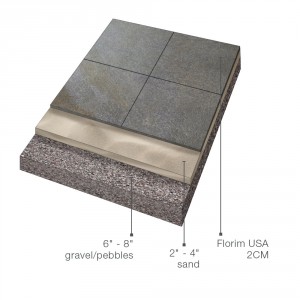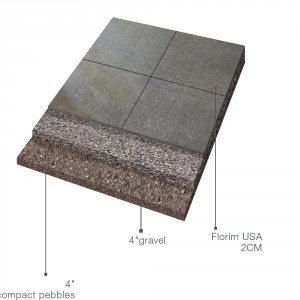Direct installation on gravel and sand
The materials can be laid easily on sand or gravel; the system is also easy to remove and reposition, thereby allowing maximum creativity in laying the materials; the system can also be applied either with minimum joint or with the slabs arranged with a joint of at least 1 cm between the slabs.
*The system cannot be used in cases where motor vehicles and/or high dynamic loads transit.


INSTALLATION STEPS
STEP 1
Level and compact the surface (sand or gravel);
STEP 2
Position the 2CM Florim porcelain tile on the gravel/sand bed;
STEP 3
Tap the tiles with a rubber hammer to eliminate any unevenness and fill the joints between the tiles with gravel/sand to add stability to the surface.
PLUS
- Easy to install and remove;
- Quick water drainage keeping the ground unchanged;
- Ideal to create continuity between indoor and outdoor flooring.
- Exhibitions and events.
GENERAL INDICATIONS
SUBSRATE
Level the substrate and compact it with care before proceeding with installation consisting of resting the slabs on the substrate. It is advisable to lay a separating cloth (geotextile) to stabilize the substrate in order to limit any washing away along the gaps / joints between the pavers and to minimize the growth of weeds.
SPACERS BETWEEN PAVERS
When laying porcelain pavers by resting them directly on the substrate, they must never be laid so that they touch each other, as this would drastically increase the risk of chipping caused by micro-movements while the pavers are setting into place.1/6″ joints are recommended for pressed material.
CUTS AND HOLES
– It is possible to cut the material in both damp or dry conditions.
– It is essential to use ONLY approved cutting wheels (continuous edge) for porcelain stoneware.
– To make holes in the slabs, use diamond drill bits for porcelain stoneware.
DO NOT USE A PLATE COMPACTOR AFTER LAYING
To avoid the risk of chipping the material, never use a plate compactor once the porcelain pavers slabs have been laid.
EDGE RESTRAINTS
When pavers are laid on draining sand or gravel, always prepare an edge restraint system to hold the substrate material used and prevent any washing away of sand or gravel, therefore keeping the paver slabs in place.
MATERIAL FOR FILLING THE JOINTS BETWEEN THE PAVERS
LAYING ON SAND
Fill the gaps with sand and eliminate the excess material. In time, wind, rain and cleaning activities may remove the sand, therefore calling for some occasional re-filling.
LAYING POLYMERIC SAND OR GRAVEL
It is a composition created specifically for outdoor paving installation. It is important to use specific sand for porcelain stoneware. This sand is available in several different colors and grain sizes. Once the polymeric sand has been compacted, it will prevent the growth of weeds. Once the gaps have been filled with polymeric sand eliminate with care all the excess material. Lastly, wet the gaps between the pavers with water to activate the reaction of the polymers that will transform the sand into a compact body.